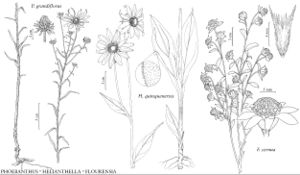Flourensia
in A. P. de Candolle and A. L. P. P. de Candolle, Prodr. 5: 592. 1836.
| Taxon | Illustrator ⠉ | |
|---|---|---|
 | Phoebanthus grandiflorus Helianthella quinquenervis Flourensia cernua | Marjorie C. Leggitt Yevonn Wilson-Ramsey Barbara Alongi |
Subshrubs or shrubs [trees], to 100 (–200) [–500+] cm. Stems erect, branched from bases or ± throughout. Leaves cauline; alternate; petiolate [nearly sessile]; blades pinnately nerved, mostly elliptic to lance-oblong or ovate, bases rounded to cuneate, margins entire [toothed], faces glabrous or ± scabrellous, usually glanddotted and vernicose. Heads discoid or radiate, borne ± singly or in ± spiciform arrays. Involucres campanulate to hemispheric, 4–20 mm diam. Phyllaries persistent, 12–40 in 2–4+ series (subequal or unequal, outer longer). Receptacles flat to conic-ovoid, paleate (paleae conduplicate, cartilaginous to scarious). Ray-florets 0 or [5–] 13–21, either neuter, or styliferous and sterile; corollas yellow. Disc-florets 10–50 [–150], bisexual, fertile; corollas yellow, tubes much shorter than cylindric-funnelform throats, lobes 5, ± deltate. Cypselae ± compressed or flattened [subterete], oblong to oblanceolate (not winged, ± sericeous); pappi persistent or tardily falling, of 2 subulate scales. x = 9.
Distribution
sw United States, Mexico, Central America, South America
Discussion
Species ca. 30 (2 in the flora).
Selected References
Lower Taxa
Key
| 1 | Shrubs; leaf blades elliptic to ovate, 10–25(–40+) × 4–15(–20) mm; ray florets 0 | Flourensia cernua |
| 1 | Subshrubs; leaf blades elliptic to lance-oblong, (20–)50–100 × 10–40+ mm; ray florets 13–21 | Flourensia pringlei |
"broader" is not a number.